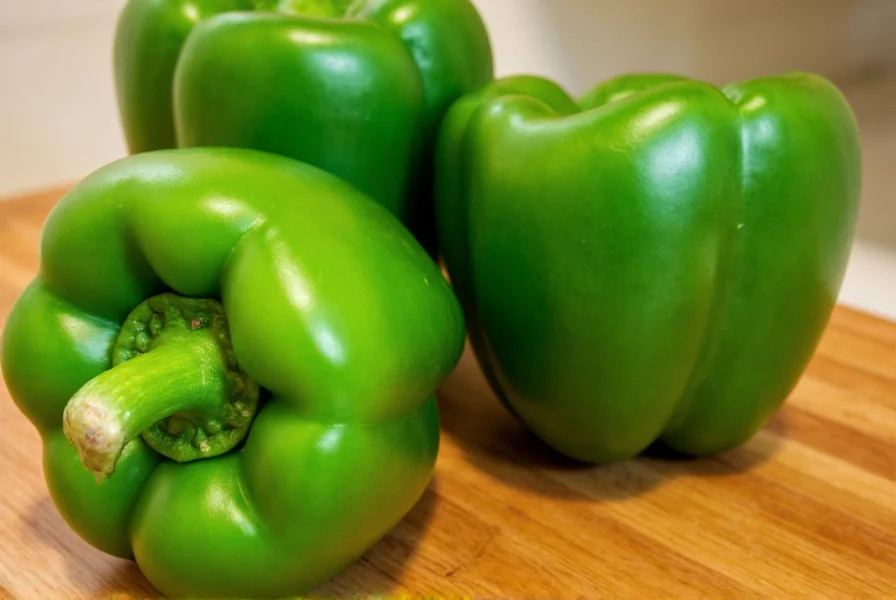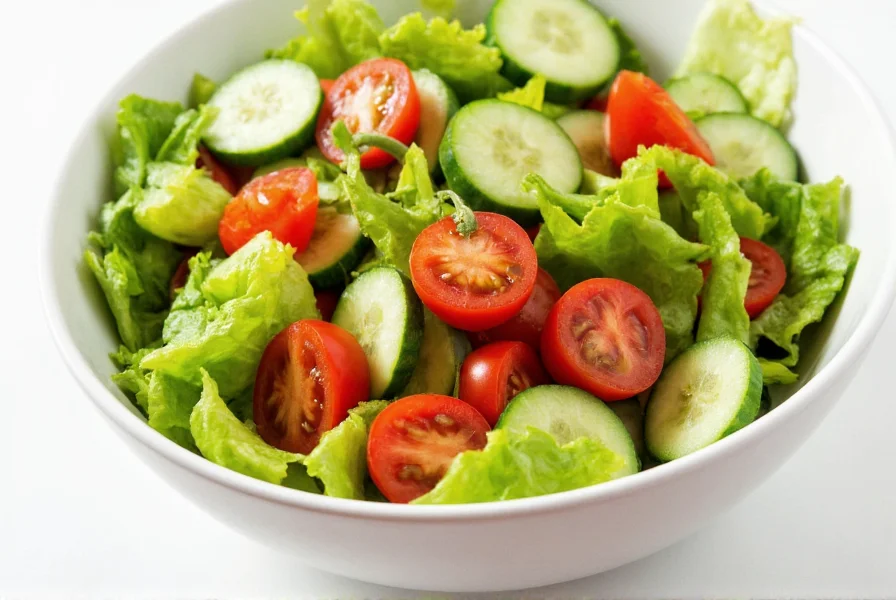Understanding the precise calorie content of foods is essential for anyone tracking their nutritional intake. Green bell peppers stand out as one of the most calorie-efficient vegetables you can add to your diet. Whether you're meal prepping, following a specific diet plan, or simply trying to make healthier choices, knowing exactly what you're consuming matters.
Green Bell Pepper Serving Sizes and Calorie Counts
The calorie count for green bell peppers varies based on serving size. Most nutritional information standardizes measurements to help with accurate tracking. Here's a detailed breakdown of calories in green bell peppers across different serving sizes:
| Serving Size | Calories | Carbohydrates (g) | Protein (g) | Fat (g) |
|---|---|---|---|---|
| 1 medium pepper (119g) | 24 | 6 | 1 | 0.2 |
| 1 cup, chopped (158g) | 32 | 7.8 | 1.5 | 0.3 |
| 100 grams | 20 | 4.6 | 0.9 | 0.2 |
| 1 ounce (28g) | 5.7 | 1.3 | 0.3 | 0.1 |
All values are based on raw green bell peppers, as cooking methods can slightly alter nutritional content. The data comes from the USDA's National Nutrient Database, the most authoritative source for food composition information in the United States.
Nutritional Profile Beyond Calories
While the low calorie count makes green bell peppers attractive for weight management, their nutritional value extends far beyond just being low in calories. These vibrant vegetables pack a powerful nutritional punch relative to their caloric content.

Green bell peppers are particularly rich in:
- Vitamin C: One medium pepper provides about 95mg, which is more than 100% of your daily recommended intake
- Vitamin A: Important for eye health and immune function
- Vitamin B6: Supports brain health and metabolism
- Dietary fiber: Approximately 2g per medium pepper, aiding digestion
- Antioxidants: Including lutein and zeaxanthin for eye health
The nutritional value of green bell peppers makes them an excellent addition to any balanced diet. Their high water content (about 92%) contributes to their low calorie density while providing hydration benefits.
Green vs. Other Bell Pepper Varieties: Calorie Comparison
Many people wonder if different colored bell peppers have different calorie counts. The truth is, the calorie difference between green, red, yellow, and orange bell peppers is minimal. The primary differences lie in their nutrient profiles as they ripen:
| Pepper Color | Calories (per 119g) | Vitamin C (mg) | Vitamin A (IU) | Notable Differences |
|---|---|---|---|---|
| Green | 24 | 95 | 313 | Least ripe, slightly more bitter taste |
| Yellow | 26 | 184 | 3,225 | Higher in vitamin C and beta-carotene |
| Orange | 25 | 157 | 2,772 | Rich in beta-carotene and vitamin A |
| Red | 25 | 190 | 3,726 | Most nutrients, sweeter flavor, highest in lycopene |
As bell peppers ripen from green to red, their sugar content increases slightly (which explains the minimal calorie difference), but they also develop higher concentrations of beneficial antioxidants and vitamins. Green bell peppers remain an excellent low-calorie option with substantial nutritional benefits.
Practical Uses for Green Bell Peppers in Your Diet
Given their extremely low calorie count and high nutritional value, green bell peppers offer tremendous flexibility in meal planning. Here are practical ways to incorporate them into your diet without significantly increasing your calorie intake:
- Raw in salads: Add crunch and flavor with minimal calories
- Stir-fries: Cook quickly to retain nutrients while adding flavor to dishes
- Stuffed peppers: Use as a low-calorie vessel for lean proteins and whole grains
- Snack sticks: Cut into strips for a satisfying, low-calorie snack with hummus
- Omelets and frittatas: Add flavor and nutrients without extra fat

For those specifically tracking calories for weight management, green bell peppers represent an ideal food. You could eat an entire medium pepper for just 24 calories while gaining valuable vitamins, minerals, and fiber. This makes them particularly valuable for those following calorie-restricted diets who still want to feel full and satisfied.
Storage Tips to Maintain Nutritional Value
To maximize the nutritional benefits of green bell peppers, proper storage is essential. Here's how to keep them fresh and nutrient-rich:
- Store unwashed peppers in the crisper drawer of your refrigerator
- Keep them in a plastic bag with small holes for airflow
- Use within 1-2 weeks for optimal freshness and nutrient retention
- Avoid storing near ethylene-producing fruits like bananas which can accelerate ripening
Properly stored green bell peppers maintain their crisp texture and nutritional content longer. When preparing them, try to minimize cooking time to preserve the maximum amount of water-soluble vitamins like vitamin C.
Green Bell Peppers in Specialized Diets
Green bell peppers fit well into numerous dietary approaches due to their low calorie count and high nutrient density:
- Keto diets: With only 6g of carbohydrates per medium pepper, they fit within most keto guidelines
- Diabetes management: Low glycemic index and high fiber content help regulate blood sugar
- Weight loss plans: High volume, low calorie nature promotes satiety
- Plant-based diets: Contribute valuable vitamins often needing attention in vegetarian/vegan diets
For those specifically asking about calories in raw green bell pepper versus cooked, the difference is minimal. Raw peppers retain slightly more vitamin C, but cooking can make certain antioxidants more bioavailable. The calorie difference between raw and cooked green bell peppers is negligible for tracking purposes.
Frequently Asked Questions
How many calories are in a cup of chopped green bell peppers?
One cup of chopped green bell peppers (approximately 158 grams) contains about 32 calories. This serving also provides 7.8 grams of carbohydrates, 1.5 grams of protein, and 0.3 grams of fat, making it an excellent low-calorie addition to meals.
Are green bell peppers good for weight loss?
Yes, green bell peppers are excellent for weight loss due to their extremely low calorie density. With only 24 calories per medium pepper and high water and fiber content, they help you feel full while consuming minimal calories. Their high nutrient content also ensures you don't sacrifice nutrition while reducing calories.
Do green bell peppers have more calories than red bell peppers?
Green bell peppers actually have slightly fewer calories than fully ripened red bell peppers, though the difference is minimal. A medium green bell pepper contains about 24 calories compared to 25-26 calories for red. The main difference is in nutrient composition, with red peppers containing more vitamins A and C as they ripen.
How does the calorie content change when green bell peppers are cooked?
Cooking green bell peppers causes minimal change to their calorie content. Since they're mostly water, some water loss during cooking might slightly concentrate the calories by weight, but the overall caloric value remains virtually identical. One medium cooked green bell pepper still contains approximately 24 calories.
What is the carbohydrate content in green bell peppers?
A medium green bell pepper (119g) contains about 6 grams of carbohydrates, with approximately 2 grams coming from dietary fiber. This means they have just 4 grams of net carbs, making them suitable for low-carb diets. The fiber content also helps regulate blood sugar and promotes digestive health.











 浙公网安备
33010002000092号
浙公网安备
33010002000092号 浙B2-20120091-4
浙B2-20120091-4